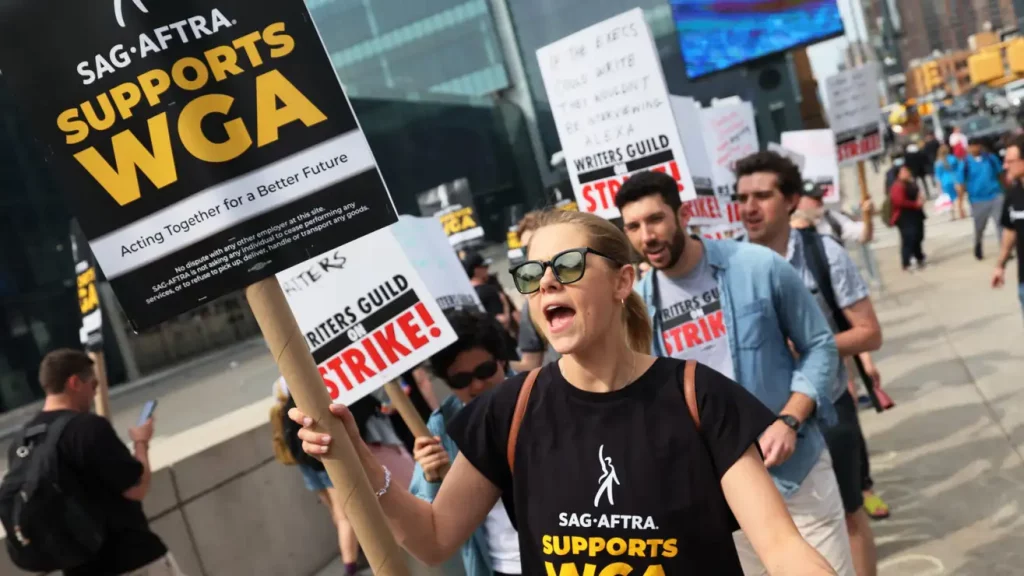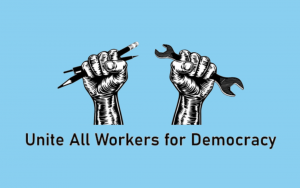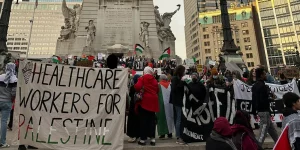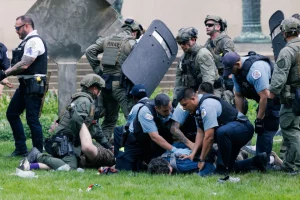On July 14, 160,000 actors organized with the Screen Actors Guild – American Federation of Television and Radio Artists (SAG-AFTRA) went on strike, marking the largest strike in the United States since the 1997 UPS Teamsters strike. These actors joined with the 11,500 screenwriters organized with the Writers Guild of America (WGA) who have been on strike since May 2. The solidarity between the two unions has been clear since the beginning, with SAG members joining WGA members on the picket line for two months before their own strike began and many making the argument that SAG needed to resist any agreement that weakened the writers’ position. This joint labor action has effectively shut down Hollywood for the foreseeable future. This comes on the heels of a year of other large strikes, mostly seen at universities, the re-emergence of the labor movement, and comes ahead of the potential UPS strike, which, if it occurs, would mean that around half a million U.S. workers (including the SAG and WGA workers) would be on strike at the same time.
These unions have shown that they are the ones who do the labor to make all the profits of Hollywood while, comparatively, receiving crumbs in return. While some actors and a few writers are able to become major stars and pull in millions of dollars, the vast majority of these workforces are precarious. Just 12.7 percent of SAG members make enough to qualify for union healthcare — meaning that the vast majority of SAG members make less than $27,000 per year. This means that the vast majority of union members have to take up other jobs just to put food on the table and pay their rent. Compare this to the average pay of a top Hollywood executive — which, as of 2021, sits at $28 million — and you can see where all the money in Hollywood is going.
“These Conditions Will Potentially Produce an Absolute Collapse of an Entire Industry”: A Crisis of Accumulation In Hollywood
The strategy of the Hollywood bosses is to continue the strike until “union members start losing their apartments and losing their houses,” but this approach has severe limits. As the former Paramount and Fox CEO put it:
What will happen is, if in fact, it doesn’t get settled until Christmas or so, then next year, there’s not going to be many programs for anybody to watch. So, you’re gonna see subscriptions get pulled, which is going to reduce the revenue of all these movie companies, television companies, the result of which is that there will be no programs… [once the] strike is settled that you want to get back up, there won’t be enough money… The truth is, this is a huge business both domestically and for world export… But these conditions will potentially produce an absolute collapse of an entire industry.
The WGA and SAG strikes have ground an ultra-lucrative industry to a halt, and continuing it will begin to severely impact the companies. However, the studios’ ability to give concessions to the unions is limited by the larger crisis of the entertainment industry. The growth of streaming has meant far more limited profits for these corporations than they saw in moments when movie tickets and commercials on TV shows were the primary way that entertainment companies made their profits. Now, the industry has shifted toward a subscription model (escalated by the pandemic), which makes it hard to define the actual profit that any individual show or movie is generating (a key consideration in the fight over residuals, which are a percentage of how much money a given piece of media generates and are paid the creatives who worked on it) and depresses profits in general.
To give an example, a Disney+ subscription (without ads) is around $11, meaning that for $11 dollars per month, users can watch as many movies and TV shows as they’d like. In comparison, the average movie ticket sits between 10 and 15 dollars, depending on location. So if a family of five gathers around the TV to watch a Disney movie on Disney+, they have effectively saved $40. This is great for consumers but bad for the studios, who have not only lost much of the revenue of cinemas but also the huge profits generated from ad sales on traditional network television. This has led the entertainment companies to begin to raise prices, institute ads on their streaming content, and limit password sharing.
But these moves alone aren’t enough to reverse the trend that has left them with less profit. So they do what capitalists always do: pass those losses onto their workers and strive to find ways to make fewer workers work longer for less.
The fight over AI is especially crucial in this context, as studios are looking to AI as a way to automate some aspects of entertainment production, which will allow them to hire fewer workers. As an example, in the final proposal from the studios to SAG before the strike, the studios proposed allowing AI scans of background actors (who make up the majority of the union), which they can use in perpetuity in return for one day’s pay. So, for the low cost of $379 (the SAG daily rate), the studio would be able to create a digital copy of an actor that they could place in the background of any scene forever. This would save productions millions of dollars because they would no longer need to pay all the actors making up the background of their scenes. It would also help break the union: it would drive the majority of the union into even more precarity, as background work — which is what most actors use to survive — would essentially disappear. When the unions call AI an “existential threat,” this is what they mean.
The political conclusions of this crisis in Hollywood show that the solidarity between the WGA and SAG isn’t just inspiring but deeply necessary. Given that executives are willing to threaten the entire industry just to avoid giving concessions to workers, solidarity between workers in the industry is vital to ensure victory in this contract fight. The different workers in Hollywood will need to stand together and ensure that they aren’t turned against each other in an attempt to weaken both struggles. However, the lessons that the struggle in Hollywood reveal go beyond just that industry and offer key conclusions for the entire working class — namely, that the bosses will do whatever they can to make us pay for their crisis, that they will use technology to do this, and that the only way to protect ourselves is to stand together and fight collectively.
The unity between the WGA and SAG-AFTRA is an incredible lesson in how to fight the capitalists, and this lesson must be pushed further. The Hollywood Teamsters standing with the two unions is a further example of the cross-union collaboration that could build and deepen this fight. Connecting the struggles of the working class across sectors helps make the labor actions more disruptive, on the one hand, and educate the workers on their class position and the need for unity, on the other. This, again, is essential if the unions are to actually win their demands. The entry of SAG into the strike strengthened the WGA immensely, and the support from other unions (both in Hollywood and outside of it) sends a clear message to the bosses that this strike has deep support and that there are other sectors which will rally to their defense if necessary. This solidarity isn’t just inspiring; it is vital as it changes the balance of forces in favor of the workers. In this spirit, we must seek to push this solidarity further and connect the struggle in Hollywood to the broader struggles of the working class.
The struggle of the Hollywood workers isn’t a fundamentally different one than the struggle of the UPS workers or the struggle of higher education workers. All of these industries rely upon the use of highly exploited and precarious labor — from adjuncts in higher ed, to the inside workers at UPS, to lowly paid actors and writers in Hollywood — to increase the amount of surplus value the bosses are able to extract from their workers. The crisis of profit accumulation in Hollywood is shared, in different ways and to different degrees, across industries because there is a more generalized crisis of capital accumulation amongst the capitalists. The workers fighting back are all, in their own ways, fighting the same fight; they are all fighting against this system that seeks to work us as hard as it can, pay us as little as possible, and keep us as isolated and disorganized as possible.
A Strike That Takes Up The Struggles of the Oppressed
Something else that has been notable about the Hollywood strikes is the way that they have been showing the important unity between the fight against exploitation and the fight against oppression. From “Pride Pickets,” to speakers at rallies taking up the question of abortion rights, to members connecting the issues of structural racism to the strike, the strikes have shown that the solidarity shown in the strike goes deeper than just between the two sister unions. Indeed, what these strikes are drawing out is that the fight against exploitation is profoundly tied to the fight against oppression. In the case of the current strike, union members and activists are pointing out that — because TV and film production happens all around the country — the laws against abortion have direct impacts on these workers’ lives. These links are necessary in order to win big in this strike.
Connecting struggles across the working class is both good in itself — as it helps show the power that labor can bring to struggles against oppression — and also tactically necessary for the unions. The strength of the bosses and their commitment to ensuring that they are able to extract as much surplus value as possible out of their workers mean that, in order to actually stand strong against them, the unions must connect to wider and more militant struggles in order to have the forces possible to win. By showing how this struggle is connected to other on-going struggles, the unions are able to show the unity between struggles and bring more people into the fight.
Speaking about how abortion rights are a labor issue for WGA and SAG members, writer and actor Zoe Kazan said:
This is what I think about when I read articles about obstetricians post-Dobbs — docs fleeing states like Idaho where they now fear legal repercussions for doing their jobs, my work as a writer and an actor has relocated me to places like that — states where getting the kind of reproductive health care that twice saved my life would be much, much harder in a post-Dobbs reality. And for what it’s worth, both times that I’ve needed reproductive surgery, I was in the middle of work on a project — I just happened to be in New York with easy access to that care.
While the WGA and some studios have agreed to pay for union members to travel to get an abortion if they need it, this is just a band-aid that doesn’t really address the actual depths of the problem. As Kazan explained:
But what happens when you don’t have time to travel to such a place, when you need surgery now, not hours from now? What happens when you don’t need an abortion but you do need reproductive care that has become much, much harder to find?
This problem is even more acute when the current spate of anti-trans laws are considered. How can trans workers work on TV and film production in states where they can’t use the bathroom, appear in public in clothing that doesn’t align with their assigned gender, or access health care? Simply having unions or studios pay for workers to travel isn’t enough to actually address this deep problem. What statements like Kazan’s point to is that the fight must go past just demanding concessions from the studios and actually fight these laws explicitly. These anti-bodily autonomy laws are a threat to the entire working class and the entire working class must organize to defeat them.
Toward a Winning Strategy for the Labor Movement, For A Working Class Party Which Fights for Socialism
The impacts and importance of the Hollywood strike goes beyond just the entertainment industry. Due to the increasing monopolization of capitalism over the last period, many of the companies involved in the strike are major corporate entities outside of the entertainment industry such as Amazon, Apple, and Comcast. These strikes, therefore, don’t just hit the profits of the entertainment industry, but some of the most powerful capitalists in the world. Seeing how these issues interconnect — that the demands of the writers and actors of Amazon shows are connected to the demands of the Amazon warehouse workers, that they are quite literally fighting the same company — shows us the potential for keeping the spirit of solidarity represented in these strikes going and deepening it to include more workers, feature more disruption, and strike at the heart of the capitalist system more deeply. Indeed, the key demands of the WGA and SAG workers about low pay, long hours, and the ways that technology is being used to attack workers are concerns shared by essentially the entire working class. These demands also speak to larger structural issues of the entertainment industry, which then also point to the larger structural issues of capitalism as a system. The effective speed-up that the entertainment industry has experienced is mirrored in the speed-ups that have happened across industries in an attempt to increase productivity in order to increase profits for the capitalists in a moment of a crisis of profit accumulation — where the capitalists, essentially, are desperately trying to find ways to extract even more profit out of workers.
Given this, no matter how strong a contract the SAG and WGA workers are able to win, it won’t be able to reverse the ongoing trends within the capitalist system that have put actors and writers in their current position. As an example of this, we can look at the 2007 WGA strike. The key demand of that strike had to do with residuals from DVD sales and the growth of “New Media” (meaning, at the time, web shows and very early streaming content). While that strike was resolved with the WGA winning key concessions, the bosses of the entertainment industry found loophole after loophole and used the growth of streaming to create the current moment of extreme precarity, underpayment, and hyper-exploitation within the entertainment industry. The contracts that the WGA and SAG workers win in this strike will, hopefully, include major concessions and gains. But it is impossible for this strike alone to rewrite the fundamental structure of the entertainment industry, which rests upon exploitation and precarity. In this sense, to actually protect the workers of the entertainment industry, we have to think beyond this strike — which, is, of course vital and must be fought with all the power that can be assembled — and toward larger strategic questions.
We simply, as the working class, cannot continue on the hamster wheel of fighting contract to contract. Once the SAG and WGA strikes resolve, it will be at least three years before they can negotiate a new one. That’s three years for the bosses to find new ways to exploit workers, new ways to use technology to eliminate workers, and new ways to weaken the working class solidarity that the SAG and WGA strike express. The bosses know that the struggle between them and their workers never stops, and we should too. In this spirit, we as a working class need to begin to organize ourselves across industries and geographic locations to build an organization that can unit our struggles and fight for them collectively with our full firepower.
This organization can join together the striking workers in Hollywood with the UPS Teamsters who are preparing for a strike, the young workers organizing unions across the country, the activists taking up the fight for abortion and trans rights, the higher education workers who have struck across the country, and the millions of people who are beginning to question capitalism as a system. Organizing all of these different struggles together allows for us to intervene in each of these struggles — from the fight against exploitation in the workplace to the fight against the far-right — with all of our power, rather than the scattered way we fight now, with each sector taking up their own fight with their own forces. This organization of the working class and oppressed can unite these struggles and push them further to not just fight for better conditions in the here-and-now but to actually bring down the system that got us here. We can use our combined power to fight the capitalist system itself and raise the banner for a better, socialist world where all can have what they need, free from capitalist exploitation and oppression. This organization — a working class party that fights for socialism — is the way to continue and deepen the inspiring solidarity we have seen in the entertainment industry.
There is clearly a fighting spirit in the labor movement and that fighting spirit must have a strategy with which to actually win that fight. Again, the bosses know that they are in a constant struggle against their workers, they know that keeping us disparate and disorganized is the way to keep themselves safe. They are afraid of us and our power. So we need to, as workers and the oppressed, take heart from the SAG and WGA strikes and push it further, organize ourselves, and fight for a better world than this one.











